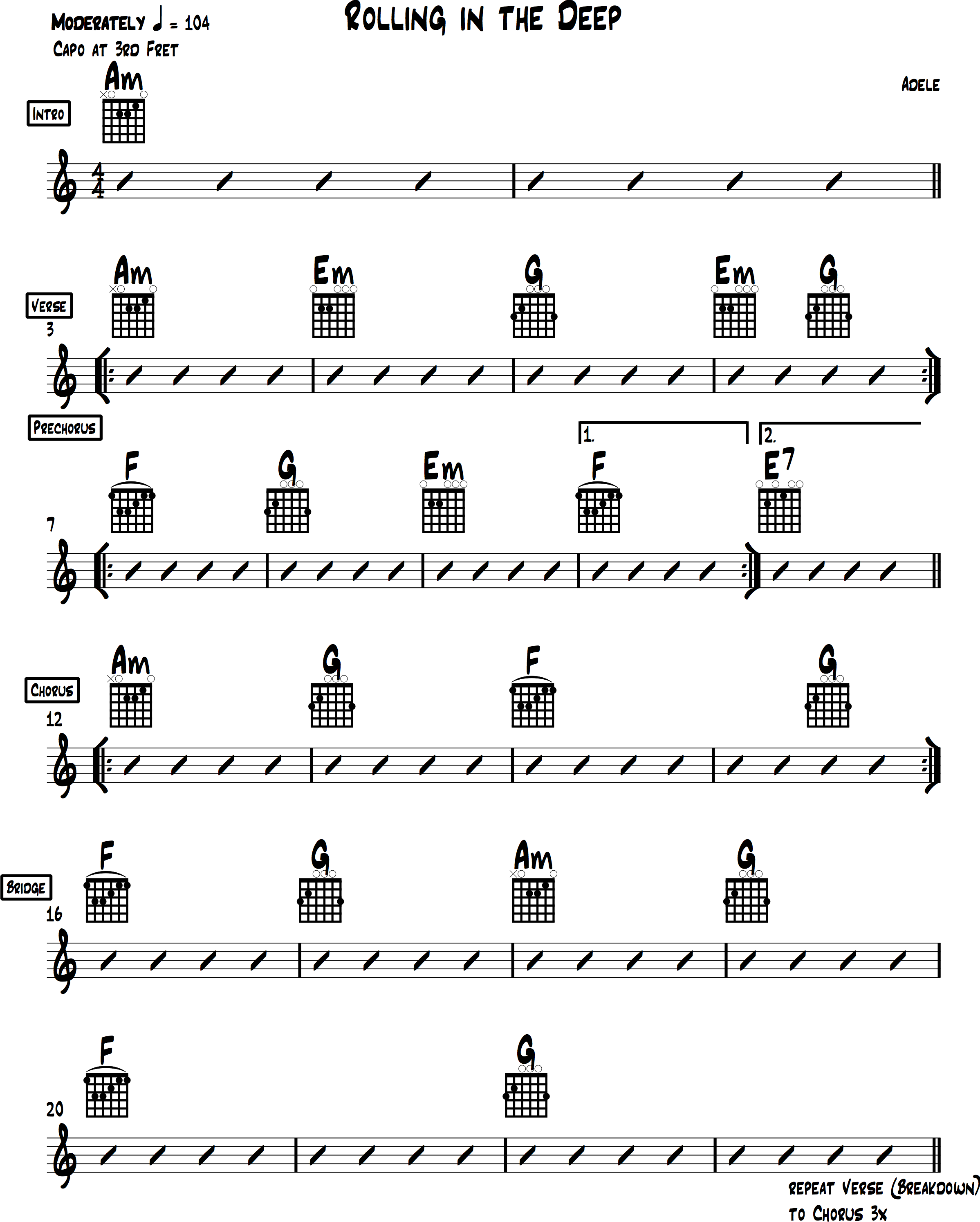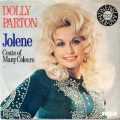
Rolling in the Deep is the opening track on Adele’s second studio album, 21. The song was written by Adele and Paul Epworth. Adele describes the song as a “dark and bluesy, gospel, disco tune” and the lyrics describe the emotions of a rejected lover. This easy acoustic guitar arrangement will have you playing the Rolling in the Deep chords in no time.
Useful links
Song Specs
Title: Rolling in the Deep
Artist: Adele
Songwriters: Adele and Paul Epworth
Album: 21
Key: A minor (Capo at 3rd fret, actual key is C minor)
Tempo: 104
Chord Progression: Am–Em–F–G–E7
Accompaniment Technique: Open Chords and Downstrums
Playing Tips
Here are some helpful tips to keep in mind. I provided some useful links above and I’ll take you through the chords, accompaniment patterns, song forms, and a chord chart. Everything you need to get started playing this tune.
Chords
| Chords w/ Capo | Am | Em | F | G | E7 |
| Actual Key | Cm | Gm | Ab | Bb | G7 |
| Progression | i | v | bVI | bVII | V7 |

Rolling in the Deep is in the key of C minor. However, by adding a capo to the 3rd fret, we can use open-position chords that will make the song much easier to perform. The capo at the 3rd fret changes the key to A minor for guitar players. We’re still in the key of C minor, but we think in the key of A minor.
Rolling in the Deep uses power chords* for most of the song. Occasionally, the full chord quality (major or minor sound) is used. This strategically adds and releases tension. In addition, by adding a few accompaniment techniques, we can also add different textures that will help propel the song forward.
*Power chords are chords that omit the 3rd. If you’re new to music theory then don’t worry about it too much. Simply focus on strumming the bottom 2 or 3 strings of each chord and you’ll be fine.
Accompaniment Technique
The strumming technique for the Rolling in the Deep chords will consist mainly of down strums with an eighth-note rhythm.
- Simply count: 1 & 2 & 3 & 4 &.
- For the majority of the song, focus on playing the bottom 2 or 3 strings of each chord.
- As the song builds, you can begin adding the full chord gradually.
- The chorus should use the entire chord sound.
- There is also a backbeat-strumming technique that helps add flavor to the chorus.
Palm Muting Technique
For the intro and the verse, I suggest using the right-hand, palm-muting technique.
- Rest the heel of your right hand on the bridge slightly muting the strings.
- This creates a deep, percussive effect that is used in rock all of the time.
This technique is very common for electric guitar playing but can be quite useful for acoustic as well.
Rolling in the Deep Chords Chart
I’ve included a Rolling in the Deep chords chart, which is a simple road map that shows you:
- The overall arrangement of the song.
- A section by section breakdown of the song.
- Each chord and how long to play it for.
If you don’t read music, please don’t be intimidated. This is a cheat sheet that can help you get through the tune quickly and easily. I find it indispensable for learning songs and I can also hand it to a seasoned musician and they can follow along without any problems.
Song Form
Intro: 2 measures of A minor.
Verse: A 4-measure pattern; Measure 1 (Am for 4 beats), Measure 2 (Em for 4 beats), Measure 3 (G for 4 beats) and Measure 4 (Em for 2 beats followed by G for 2 beats) then the 4-measure pattern repeats.
Prechorus: 4-measure pattern; Measure 1 (F for 4 beats), Measure 2 (G for 4 beats), Measure 3 (Em for 4 beats) and Measure 4 (F for 4 beats the first time then E7 on the repeat)
Chorus: 4-measure pattern; Measure 1 (Am for 4 beats), Measure 2 (G for 4 beats), Measure 3 (F for 4 beats) and Measure 4 (stays on F for 2 beats followed by G for 2 beats) then the 4-measure pattern repeats.
Bridge: 8-measure pattern; Measure 1 (F for 4 beats), Measure 2 (G for 4 beats), Measure 3 (Am for 4 beats) and Measure 4 (G for 4 beats), Measure 5 and 6 (F for 8 beats), and Measures 7 and 8 (G for 8 beats)
Once you become familiar with chord charts, you’ll never want to go back. It’s just easier to see where you’re going when you have a map. And, it’s especially helpful when you’re not familiar with the song or there’s a section of the song that you don’t remember (Bridges and Interludes are notorious surprises that can derail a song’s performance).

Wrap-up
Rolling in the Deep is a modern classic. Begin strumming the chords to this song and there’ll be no shortage of singers that will begin their scorned-lover battle cry.
I hope that you’ve enjoyed this easy acoustic guitar arrangement of the Rolling in the Deep chords and I thank you for hanging with me.







